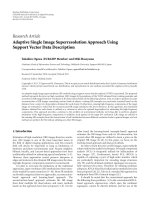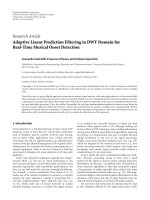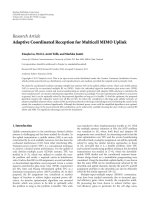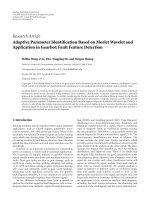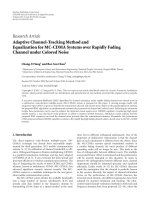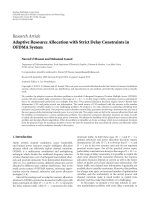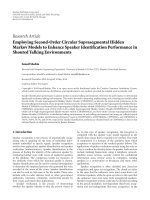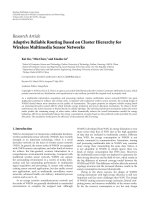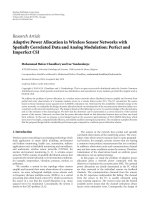Báo cáo hóa học: " Research Article Adaptive Bandwidth Management and Joint Call Admission Control to Enhance System Utilization and QoS in Heterogeneous Wireless Networks" pptx
Bạn đang xem bản rút gọn của tài liệu. Xem và tải ngay bản đầy đủ của tài liệu tại đây (852.65 KB, 11 trang )
Hindawi Publishing Corporation
EURASIP Journal on Wireless Communications and Networking
Volume 2007, Article ID 34378, 11 pages
doi:10.1155/2007/34378
Research Article
Adaptive Bandwidth Management and Joint Call
Admission Control to Enhance System Utilization and
QoS in Heterogeneous Wireless Networks
Olabisi E. Falowo and H. Anthony Chan
Department of Electrical Engineering, University of Cape Town, Private Bag X3, Rondebosch 7701, South Africa
Received 30 May 2007; Accepted 18 September 2007
Recommended by Athanasios V. Vasilakos
The coexistence of different cellular networks in the same area necessitates joint radio resource management for enhanced QoS
provisioning and efficient radio resource utilization. We propose adaptive bandwidth management and joint call admission con-
trol (JCAC) scheme for heterogeneous cellular networks. The objectives of the proposed adaptive JCAC scheme are to enhance
average system utilization, guarantee QoS requirements of all accepted calls, and reduce new call blocking probability and handoff
call dropping probability in heterogeneous wireless networks. We develop a Markov chain model for the adaptive JCAC scheme
and derive new call blocking probability, handoff call dropping probability, and average system utilization. Performance of the
proposed adaptive JCAC scheme is compared with that of nonadaptive JCAC scheme in the same heterogeneous wireless network.
Results show an improvement in average system utilization of up to 20%. Results also show that connection-level QoS can be
significantly improved by using the proposed adaptive JCAC scheme.
Copyright © 2007 O. E. Falowo and H. A. Chan. This is an open access article distributed under the Creative Commons
Attribution License, which permits unrestricted use, distribution, and reproduction in any medium, provided the original work is
properly cited.
1. INTRODUCTION
The coexistence of different cellular networks in the same
geographical area necessitates joint radio resource manage-
ment (JRRM) for enhanced QoS provisioning and efficient
radio resource utilization. The concept of JRRM arises in or-
dertoefficiently manage the common pool of radio resources
that are available in each of the existing radio access tech-
nologies (RATs) [1, 2]. In heterogeneous cellular networks,
the radio resource pool consists of resources that are avail-
able in a set of cells, typically under the control of a radio
network controller or a base station controller.
Not many approaches to JRRM are available in the liter-
ature. The interest has been mainly focused on architectural
aspects of JRRM, and not many specific algorithms have been
provided to investigate JRRM among different RATs, even in
simple scenarios [3]. Therefore, this paper focuses on joint
call admission control (JCAC) algorithm which is one of the
JRRM algorithms.
Call admission control (CAC) algorithm is one of the
radio resource management (RRM) algorithms. The tradi-
tional call admission control (CAC) algorithms for homo-
geneous cellular network determine whether or not a user
may be admitted into the network. Many CAC algorithms
have been developed for homogeneous cellular network, and
a review of these CAC algorithms appears in [4, 5]. However,
homogeneous CAC algorithms do not provide a single solu-
tion to address the heterogeneous architectures which char-
acterize next generation wireless network [6]. This limita-
tion of homogeneous CAC algorithms necessitates the devel-
opment of JCAC algorithms for heterogeneous wireless net-
works.
However, unlike homogeneous CAC algorithms, JCAC
algorithms do not only decide whether an incoming call can
be accepted or not. They also decide which of the available
radio access networks is best suited to accommodate the in-
coming call. JCAC algorithms must manage individual ser-
vices and technologies, and ensure that the QoS require-
ments of all admitted calls are satisfied while at the same time
making the best use of the total resources available in the het-
erogeneous network.
Gelabert et al. [7] study the impact of load balancing
among different RATs in heterogeneous cellular networks.
However, handoff calls are not considered in the study. The
2 EURASIP Journal on Wireless Communications and Networking
algorithm deals with initial RAT selection only for new calls.
Moreover, no analytical model is presented in the study.
Pillekeit et al. [8] propose a forced load balancing al-
gorithm for heterogeneous UMTS/GSM network with colo-
cated cells. In their approach, all the cells in the heteroge-
neous network are classified into two groups: over-loaded
cells and under-loaded cells. The load balancing algorithm
is triggered when a certain load threshold is exceeded in or-
der to balance the traffic load in the heterogeneous network.
However, the algorithm treats both new calls and handoff
calls alike. In practice, it is necessary to keep handoff call
dropping probability below new call blocking probability.
Moreover, no analytical model is presented in the study.
Romero et al. [9] propose a service-based RAT selection
policy for heterogeneous wireless networks. They illustrate
the selection policy using heterogeneous network compris-
ing GERAN and UTRAN, and a mix of voice and interactive
users (e.g., www browsing). Examples of the service-based
selection policies are defined in the following [9].
(i) VG (voice GERAN) policy: this policy has only the
service class as input and allocates voice users into GERAN
and other services into UTRAN.
(ii) VU (voice UTRAN) policy: this policy acts in the op-
posite direction as VG and allocates voice users to UTRAN
and interactive users to GERAN.
In the previous works mentioned above, no analytical
model has been developed for JCAC algorithms in order
to investigate connection-level QoS parameters in heteroge-
neous cellular networks. Therefore, this paper models and
analyzes a JCAC algorithm in heterogeneous cellular net-
works.
We propose adaptive bandwidth management and JCAC
(AJCAC) scheme to enhance system utilization and connec-
tion-level QoS in heterogeneous cellular networks support-
ing multiple classes of calls such as voice and video. The pro-
posed AJCAC scheme is designed to simultaneously achieve,
the following objectives:
(1) distribute traffic load uniformly among available RATs
to improve average system utilization,
(2) guarantee the QoS requirement of all admitted calls,
(3) prioritize handoff calls over new calls,
(4) adapt the bandwidth of ongoing calls to improve
connection-level QoS and system utilization.
Uniform distribution of traffic load among multiple
RATs in heterogeneous wireless network allows for a better
utilization of the radio resources. QoS requirements of all
admitted calls are guaranteed by allocating to each of the
calls at least the minimum bandwidth needed. Handoff calls
are prioritized over new calls by using different call rejection
thresholds for new and handoff calls, and also by using dif-
ferent bandwidth adaptation mechanism for new and hand-
off calls. To the best of our knowledge, developing a scheme
that achieves the above objectives at the same time in hetero-
geneous wireless network is a novel work.
The contributions of this paper are twofold. Firstly,
we combine adaptive bandwidth management and JCAC
scheme to enhance system utilization and connection-level
QoS in heterogeneous wireless networks. Secondly, we de-
RAT 1
RAT 2
1a
2a
MT
1b
2b
1c
2c
Agroupof
co-located
cells
Figure 1: Two-RAT heterogeneous cellular networks with colocated
cells.
velop an analytical model for the AJCAC scheme, derive aver-
age system utilization, new call blocking probability, handoff
call dropping probability, and examine the tradeoff between
new call blocking and handoff call dropping.
The rest of this paper is organized as follows. Section 2
presents the system model for heterogeneous wireless net-
works. In Section 3, the components of the AJCAC scheme
are described. Section 4 presents the Markov chain model of
the AJCAC scheme. In Section 5, we investigate the perfor-
mance of the AJCAC scheme through simulations.
2. SYSTEM MODEL AND ASSUMPTIONS
We consider a heterogeneous cellular network which con-
sists of J number of RATs with colocated cells, similar to
[7, 8]. Cellular networks such as GSM, GPRS, UMTS, and
so forth can have the same and fully overlapped coverage,
which is technically feasible, and may also save installation
cost [10]. Figure 1 illustrates a two-RAT heterogeneous cel-
lular network.
In heterogeneous cellular networks, radio resources can
be independently or jointly managed. We consider a situa-
tion where radio resources are jointly managed in the het-
erogeneous network and each cell in RAT-j (j
= 1, , J)
has a total of Bj basic bandwidth units (bbu). The physical
meaning of a unit of radio resources (such as time slots, code
sequence, etc.) is dependent on the specific technological im-
plementation of the radio interface [11]. However, no matter
which multiple access technology (FDMA, TDMA, CDMA,
or OFDM) is used, we could interpret system capacity in
terms of effective or equivalent bandwidth [12–14]. There-
fore, whenever we refer to the bandwidth of a call, we mean
the number of bbu that is adequate for guaranteeing the de-
sired QoS for this call, which is similar to the approach used
for homogeneous networks in [14–16].
It is assumed that packet-level QoS is stochastically as-
sured by allocating at least the minimum effective band-
width required to guarantee a given maximum probability
on packet drop, delay, and jitter [17].
Our approach is based on decomposing heterogeneous
cellular network into groups of colocated cells. As shown in
Figure 1,cell1aandcell2aformagroupofcolocatedcells.
Similarly, cell 1b and cell 2b form another group of colo-
cated cells, and so on. Based on the following assumption-
commonly made in homogeneous cellular networks, we as-
sume that the types and amount of traffic are statistically the
same in all cells of each RATs [14, 15, 18, 19]. Therefore, the
types and amount of traffic are statistically the same in all
groups of colocated cells.
O. E. Falowo and H. A. Chan 3
A newly arriving call will be admitted into one of the cells
in the group of colocated cells where the call is located. When
a mobile subscriber using a multimode terminal and having
an ongoing call is moving from one group of colocated cells
to another group of co-located cells, the ongoing call must
be handed over to one of the cells in the new group of colo-
cated cells. For example (Figure 1), an ongoing call can be
handed over from cell 2a to cell 2b or from cell 2a to cell 1b.
Note that the handover consists of both horizontal and verti-
cal handovers.
The correlation between the groups of colocated cells
results from handoff connections between the cells of cor-
responding groups. Under this formulation, each group of
co-located cells can be modeled and analyzed individually.
Therefore, we focus our attention on a single group of colo-
cated cells.
The heterogeneous network supports K classes of calls.
Each class is characterized by bandwidth requirement, ar-
rival distribution, and channel holding time. Each class-i
call requires a discrete bandwidth value, b
i,w
,whereb
i,w
be-
longs to the set B
i
={b
i,w
} for i = 1, 2, , K and w =
1, 2, , W
i
. W
i
is the number of different bandwidth values
that a class-i call can be allocated. b
i,1
(also denoted as b
i,min
)
and b
i,W
i
(also denoted as b
i,max
) are, respectively, the min-
imum and maximum bandwidth that can be allocated to a
class-i call. Note that b
i,w
<b
i,(w+1)
for i = 1, 2, , K and
w
= 1, 2, ,(W
i
−1).
The requested bandwidth of an incoming class-i call is
denoted by b
i,req
,whereb
i,req
∈ B
i
.Letm
i,j
and n
i,j
denote,
respectively, the number of ongoing new class-i calls and
handoff class-i calls, in RAT-j with 1
≤ c ≤ m
i,j
(for new
calls) and 1
≤ c ≤ n
i,j
(for handoff calls). Let b
i,assigned c
de-
note the bandwidth assigned to call c of class-i in RAT- j in
the group of colocated cells, where b
i,assigned c
∈ B
i
.Acallc
of class-i is degraded if b
i,assigned c
<b
i,req
whereas the call is
upgraded if b
i,assigned c
>b
i,req
.
If a class of calls (i.e., class-i calls) requires a fixed number
of bbu (i.e. constant bit-rate service), it becomes a special
case in our model in which b
i,min
= b
i,max
and the set B
i
has
only one element. However, it will not be possible to upgrade
or degrade this class of calls.
Following the general assumption in cellular networks,
new and handoff class-i callsarriveinthegroupofcolocated
cells according to Poisson process with rate λ
n
i
and λ
h
i
,re-
spectively. The call holding time (CHT) of a class-i call is as-
sumed to follow an exponential distribution with mean 1/μ
i
[18, 19].
To characterize mobility, the cell residence time (CRT),
that is, the amount of time during which a mobile terminal
stays in a cell (same as the time, it stays in a group of colo-
cated cells) during a single visit, is assumed to follow an ex-
ponential distribution with mean 1/h, where the parameter
h represents the call handoff rate. We assume that the CRT is
independent of the service class.
The channel holding time is the minimum of the CHT
and the CRT. Because minimum of two exponentially dis-
tributed random variables is also exponentially distributed
[20], the channel holding time for new class-i calls, and
for handoff class-i call, is assumed to be exponentially dis-
tributed with means 1/μ
n
i
and 1/μ
h
i
,respectively.
Note that this set of assumptions has been widely used
for homogeneous cellular networks in the literature, and is
found to be generally applicable in the environment where
the number of mobile users is larger than the number of
channels [20].
3. PROPOSED AJCAC SCHEME
In this section, we describe the proposed AJCAC scheme
which consists of the following three components: joint call
admission controller, threshold-based bandwidth reserva-
tion unit, and bandwidth adaptation (BA) controller. These
components are described in the following.
3.1. The joint call admission controller
The joint call admission controller implements the JCAC
algorithm. The basic function of the JCAC algorithm is to
make call admission decision and uniformly distribute traf-
fic load among all the available RATs in the network.
During call setup, a multimode mobile terminal request-
ing a service sends a request to the joint call admission con-
troller which implements the JCAC algorithm. The service
request contains the call type, service class, and bandwidth
requirements. The JCAC procedure is shown in Figure 2,
where x
i,j
and y
i,j
denote, respectively, the residual bbu avail-
able in RAT-j for new and handoff class-i calls. Whenever
a call arrives, the JCAC attempts to allocate the maximum
bbu for this call (i.e., set b
i,req
= b
i,max
) provided that the
available bbu in the selected RAT is greater than or equal to
b
i,max
. If the available bbu in the selected RAT is less than
b
i,max
but greater than or equal to b
i,req
, the call will be as-
signed a bandwidth between b
i,req
and b
i,max
. If the available
bbu is less than b
i,req
but greater than or equal to b
i,1
(b
i,min
),
the call will be assigned a bandwidth between b
i,1
and b
i,req
.
If the available bbu in all the RATs is less than b
i,1
,BAal-
gorithm (BAA) will be invoked to reduce the bandwidth of
some ongoing call(s) in the chosen RAT. If the available bbu
is still less than b
i,1
for all available RATs, the call will be re-
jected.
For new class-i calls, let C
n
i,j
denote the total bbu available
in RAT-j, α
i,j
the fraction of bbu available in RAT-j over the
summation of bbu available in all RATs, x
i,j
the residual bbu
available in RAT-j,andL
n
i,j
the current load in RAT-j.For
handoff class-i calls, the corresponding values are C
h
i,j
, β
i,j
,
y
i,j
,andL
h
i, j
. Then
α
i,j
=
C
n
i,j
J
j
=1
C
n
i,j
∀i, j,
J
j=1
α
i,j
= 1 ∀i.
(1)
4 EURASIP Journal on Wireless Communications and Networking
Reject class-i call
Ye s
n>J
No
n ++
No
b
i,min
≤ y
ij
Ye s
Admit class-i
call into the n
th
RAT and
allocate b
i,min
Select the n
th
RAT
and apply BAA
n
= 1
Ye s
b
i,req
<b
i,min
No
b
i,req
= b
i,(req−1)
n = 1
Ye s
n>J
No
n ++
No
b
i,req
≤ y
ij
Ye s
Admit
class-i
call in the
n
th
RAT
and allocate
b
i,req
Select the n
th
RAT
Sort RAT
j
for all j in
increasing order of current
load L
h
ij
,andsetn = 1
(Handoff call)
No
Arrival of class-i call
New call?
Ye s
Reject class-i call
Ye s
n>J
No
n ++
No
b
i,min
≤ x
ij
Ye s
Admit
class-i
call into the
n
th
RAT
and allocate
b
i,min
Select the n
th
RAT
and apply BAA
n
= 1
Ye s
b
i,req
<b
i,min
No
b
i,req
= b
i,(req−1)
n = 1
Ye s
n>J
No
n ++
No
b
i,req
≤ x
ij
Ye s
Admit
class-i
call into the
n
th
RAT
and allocate
b
i,req
Select the n
th
RAT
Sort RAT
j
for all j in
increasing order of current
load L
n
ij
,andsetn = 1
Figure 2: Proposed adaptive load-based JCAC algorithm.
λ
n
i
JCAC
λ
n
i,1
λ
n
i,2
λ
n
i,J
RAT 1
RAT 2
RAT J
Figure 3: Splitting of the arraival process in the group of colocated
cells.
Similarly,
β
i,j
=
C
h
i,j
J
j
=1
C
h
i,j
∀i, j,
J
j=1
β
i,j
= 1 ∀i.
(2)
When a new or handoff callarrivesintoagroupofcolocated
cells, the JCAC algorithm selects the least loaded RAT avail-
able for the incoming call. The action of selecting a RAT for
each arriving new or handoff call in the group of colocated
cells leads to splitting of the arrival process. Figure 3 illus-
trates the splitting of the arrival among J number of RATs in
the group of colocated cells.
As shown in Figure 3, the arrival rate in the group of colo-
cated cells is split among all the available RATs. Each RAT has
afractionofthearrivalrate(λ
n
i
). Due to the uniform-load-
distribution action of the JCAC algorithm, the mean arrival
rates of class-i calls into each RAT in the group of collocated
cells are as follows:
λ
n
i,j
= α
i,j
λ
n
i
∀i, j,
λ
n
i
=
J
j=1
λ
n
i,j
∀i.
(3)
Similarly
λ
h
i,j
= β
i,j
λ
h
i
∀i, j,
λ
h
i
=
J
j=1
λ
h
i,j
∀i,
(4)
O. E. Falowo and H. A. Chan 5
RAT 1 RAT 2
Access
networks
Available
bandwidth
B
1
= t
21
t
11
t
01
B
2
= t
22
t
12
t
02
Figure 4: Accessible bandwidth for a two-class, two-RAT system.
where λ
n
i
and λ
h
i
denote the arrival rates of new class-i calls
and handoff class-i calls, respectively, into the group of co-
located cells. λ
n
i,j
and λ
h
i,j
denote the arrival rates of new class-
i calls and handoff class-i calls, respectively, into RAT- j in the
groupofcolocatedcells.
The arrival rates of a split Poisson process are also Pois-
son [21]. Therefore, given that the mean arrival rate of class-
i calls into the group of colocated cells is Poisson, the mean
arrival rates of the split class-i calls into RAT-1, RAT-2, ,
RAT-J are also Poisson.
3.2. Threshold-based bandwidth reservation unit
In order to maintain lower handoff dropping probability, the
bandwidth reservation unit implements a bandwidth reser-
vation policy that uses different thresholds for new and hand-
off calls. Figure 4 shows the bandwidth reservation policy for
a two-class, two-RAT system.
The policy reserves bandwidth for aggregate handoff
calls, thus gives them priority over new calls. The policy also
prioritizes among different classes of handoff calls according
to their QoS constraints by assigning a series of bandwidth
thresholds t
1,j
, t
2,j
, , t
k, j
, for handoff calls such that
t
0,j
≤ t
1,j
≤ ··· ≤t
i,j
≤ t
(i+1),j
≤···≤t
k, j
= B
j
∀j,
(5)
where t
0,j
denotes the total number of bbu available for all
new calls in RAT-j,andt
i,j
denotes the total number of bbu
available for handoff class-i calls in RAT-j. B
j
denotes the
total number of bbu available in RAT-j.
3.3. Bandwidth adaptation controller
The bandwidth adaptation controller executes the BAA
which is triggered when a new call arrives or when a call is
completed. Most multimedia applications are adaptive. For
example, voice can be encoded at 16 kbps, 32 kbps, 64 kbps,
and 128 kbps by choosing appropriate encoding mecha-
nisms. Similarly, video applications can be made rate adap-
tive by using, for instance, a layered coding method. In layer
coding method, the lowest layer (i.e., the base layer) con-
tains the critical information for decoding the image se-
quence at its minimum visual quality. Additional layers pro-
vide increasing quality. All these encoded layers may be trans-
mitted when the network is underutilized. However, when
the network resources are being fully utilized, only based
layer(s) which contain critical information may be transmit-
ted.
As an illustration, if one would watch a 30-minute
video clip encoded at 256 kbps and 64 kbps respectively. At
256 kbps, one will see better pictures with better resolution
than at 64 kbps. Therefore, the bandwidth adaptation af-
fects the quality of the real-time applications rather than the
transmission time. However, the minimum requested QoS is
maintained by ensuring that the bbu of the calls are not de-
graded below the required minimum.
In the proposed AJCAC scheme, when the system is un-
derutilized, all arriving new and handoff class-i calls are ad-
mitted by the JCAC algorithm with the highest bandwidth
level (i.e., b
i,max
) for the calls. This approach increases band-
width utilization for the heterogeneous wireless network.
However, when the network resources are being fully utilized,
bandwidth adaptation controller is invoked to execute BAA
onarrivalofaneworhandoff call.
The BAA is triggered whenever there is a call arrival
event or a call departure event. The BAA performs two main
procedures: downgrades and upgrades ongoing calls. The
downgrading procedure is activated in the arrival epoch (i.e.,
when a new or handoff arrives to an overloaded group of
colocated cells). BAA reduces the bandwidth of some on-
going call(s) randomly selected in the system to free just
enough bbu to accommodate the incoming call. Note that
an adaptive class-i call is never degraded below the mini-
mum bbu necessary to guarantee its minimum QoS require-
ments. The upgrading procedure is activated in the departure
epoch.
In the arrival epoch, the BAA downgrading procedure
can be implemented in two ways. In the first implementa-
tion, only ongoing new calls can be downgraded to accom-
modate an incoming new call whereas both ongoing new
and handoff calls can be downgraded to accommodate an in-
coming handoff call. This approach further prioritizes hand-
off calls over new calls, in addition to the prioritization ob-
tained by using different rejection thresholds for new and
handoff calls. In the second implementation, both new and
handoff calls can be downgraded to accommodate an incom-
ing new (or handoff) call. In this implementation, prioriti-
zation of handoff calls over new calls can only be achieved
by using different rejection threshold for new and handoff
calls.
In the departure epoch, when a call departs from a RAT
in the group of colocated cells, some of the ongoing call(s)
randomly selected in RAT of the group of colocated cells may
be upgraded by the BAA algorithm.
4. MARKOV CHAIN ANALYSIS OF THE AJCAC SCHEME
The AJCAC policy described in Section 3 is a multidimen-
sional Markov chain. The state space of the group of co-
located cells can be represented by a (2
∗
K
∗
J)-dimensional
vector given as
Ω
=
m
i,j
, n
i,j
: i = 1, , k, j = 1, , J
. (6)
6 EURASIP Journal on Wireless Communications and Networking
The nonnegative integer m
i,j
denotes the number of on-
going new class-i calls in RAT-j, and the nonnegative integer
n
i,j
denotes the number of ongoing handoff class-i calls in
RAT-j.LetS denote the state space of all admissible states of
the group of colocated cells as it evolves over time. An ad-
missible state s is a combination of the numbers of users in
each class that can be supported simultaneously in the group
of colocated cells while maintaining adequate QoS and meet-
ing resource constraints. The state S of all admissible states is
given as
S
=
Ω =
m
i,j
, n
i,j
: i = 1, , k, j = 1, , J
:
k
i=1
m
i,j
c=1
b
i,assigned
c
≤ t
n
0,j
∀j
n
i,j
c=1
b
i,assigned
c
≤ t
h
i,j
∀i, j
k
i=1
m
i,j
c=1
b
i,assigned
c
+
k
i=1
n
i,j
c=1
b
i,assigned
c
≤ B
j
∀j
.
(7)
The constraints simply state that the sum of the band-
width units of all admitted class-i calls cannot be more than
the total bandwidth units available for that class of calls.
Given that the system is in the current state, s, for the AJ-
CAC scheme, the state transition could be triggered by any
of the following events.
(1) Admission of a new class-i call into RAT-j with the
successor state s
+1
1
and transition rate q(s, s
+1
1
). It follows that
q
s, s
+1
1
= λ
n
i,j
, s, s
+1
1
∈ S. (8)
(2) Admission of a handoff class-i call into RAT-j with the
successor state s
+1
2
and transition rate q(s, s
+1
2
). It follows that
q
s, s
+1
2
=
λ
h
i,j
, s, s
+1
2
∈ S. (9)
(3) Departure of a new class-i call from RAT-j with the
successor state s
−1
1
and transition rate q(s, s
−1
1
). It follows that
q
s, s
−1
1
=
m
i,j
μ
n
i
, s, s
−1
1
∈ S. (10)
(4)Departureofahandoff class-i call from RAT- j with
the successor state s
−1
2
and transition rate q(s, s
−1
2
). It follows
that
q(s, s
−1
2
) = n
i,j
μ
h
i
, s, s
−1
2
∈ S, (11)
where s, s
+1
1
, s
−1
1
, s
+1
2
,ands
−1
2
are the following matrices:
s
=
⎡
⎢
⎢
⎢
⎢
⎢
⎢
⎢
⎢
⎢
⎢
⎢
⎢
⎢
⎢
⎢
⎢
⎢
⎢
⎢
⎢
⎢
⎢
⎣
m
11
··· m
1j
··· m
1J
.
.
.
.
.
.
.
.
.
m
i1
··· m
ij
··· m
iJ
.
.
.
.
.
.
.
.
.
m
K1
··· m
Kj
··· m
KJ
n
11
··· n
1j
··· n
1J
.
.
.
.
.
.
.
.
.
n
i1
··· n
ij
··· n
iJ
.
.
.
.
.
.
.
.
.
n
K1
n
Kj
n
KJ
⎤
⎥
⎥
⎥
⎥
⎥
⎥
⎥
⎥
⎥
⎥
⎥
⎥
⎥
⎥
⎥
⎥
⎥
⎥
⎥
⎥
⎥
⎥
⎦
,
s
±1
1
=
⎡
⎢
⎢
⎢
⎢
⎢
⎢
⎢
⎢
⎢
⎢
⎢
⎢
⎢
⎢
⎢
⎢
⎢
⎢
⎢
⎢
⎢
⎢
⎣
m
11
··· m
1j
··· m
1J
.
.
.
.
.
.
.
.
.
m
i1
··· m
ij
±1 ··· m
iJ
.
.
.
.
.
.
.
.
.
m
K1
··· m
Kj
··· m
KJ
n
11
··· n
1j
··· n
1J
.
.
.
.
.
.
.
.
.
n
i1
··· n
ij
··· n
iJ
.
.
.
.
.
.
.
.
.
n
K1
n
Kj
n
KJ
⎤
⎥
⎥
⎥
⎥
⎥
⎥
⎥
⎥
⎥
⎥
⎥
⎥
⎥
⎥
⎥
⎥
⎥
⎥
⎥
⎥
⎥
⎥
⎦
,
s
±1
2
=
⎡
⎢
⎢
⎢
⎢
⎢
⎢
⎢
⎢
⎢
⎢
⎢
⎢
⎢
⎢
⎢
⎢
⎢
⎢
⎢
⎢
⎢
⎢
⎣
m
11
··· m
1j
··· m
1J
.
.
.
.
.
.
.
.
.
m
i1
··· m
ij
··· m
iJ
.
.
.
.
.
.
.
.
.
m
K1
··· m
Kj
··· m
KJ
n
11
··· n
1j
··· n
1J
.
.
.
.
.
.
.
.
.
n
i1
··· n
ij
±1 ··· n
iJ
.
.
.
.
.
.
.
.
.
n
K1
n
Kj
n
KJ
⎤
⎥
⎥
⎥
⎥
⎥
⎥
⎥
⎥
⎥
⎥
⎥
⎥
⎥
⎥
⎥
⎥
⎥
⎥
⎥
⎥
⎥
⎥
⎦
.
(12)
The decision epochs are the arrival or departure of a new
or handoff call. Joint call admission decisions are taken in
the arrival epoch. Every time a new or handoff class-i call
arrives in the group of colocated cells, the JCAC algorithm
decides whether or not to admit the call, and in which RAT
to admit it. Note that call admission decision is made only at
the arrival of a call, and no call admission decision is made
in the group of colocated cells when a call departs. When the
system is in state s, an accept in RAT-j/reject decision must
be made for each type of possible arrival, that is, an arrival of
a new class-i call, or the arrival of a handoff class-i call in the
group of colocated cells. The following are the possible JCAC
decisions in the arrival epoch.
(1) Reject the class-i call (new or handoff) in the group
of collocated cells, in which case the state s does not evolve.
(2) Admit the class-i call into RAT-j without adapting
the bandwidth of ongoing call(s) in the RAT, in which case
the state s evolves.
O. E. Falowo and H. A. Chan 7
(3) Admit the class-i call into RAT-j after adapting the
bandwidth of ongoing call(s) in the RAT, in which case state
s evolves.
Thus, the call admission action space A can be expressed
as follows:
A
=
a =
a
n
1
, , a
n
k
, a
h
1
, , a
h
k
:
a
n
i
, a
h
i
∈
0, ±1, , ±j,±
j +1
, , ±J
,
i
= 1, , k
,
(13)
where a
n
i
denotes the action taken on arrival of a new class-i
call within the group of colocated cells, and a
h
i
denotes the
action taken on arrival of a handoff class-i call from an adja-
cent group of colocated cells. a
n
i
(or a
h
i
) = 0 means reject the
new class-i (or handoff class-i)call.a
n
i
(or a
h
i
) = +1 means ac-
cept the new class-i (or handoff class-i) call into RAT-1 with-
out adapting the bandwidth of existing call(s). a
n
i
(or a
h
i
) =
−1 means accept the new class-i (or handoff class-i) call into
RAT-1 after adapting (degrading) the bandwidth of existing
call(s). a
n
i
(or a
h
i
) = + j means accept the new class-i (or hand-
off class-i) call into RAT- j without adapting the bandwidth
of existing call. a
n
i
(or a
h
i
) = −j means accept the new class-i
(or handoff class-i) call into RAT- j after adapting (degrad-
ing) the bandwidth of existing call(s).
In the departure epoch, the bandwidth adaptation unit
makes the decision to adapt (upgrade) or not to adapt the
bandwidth of ongoing call(s). Thus, the call departure action
space W can be expressed as follows:
W
=
w =
0, 1
, (14)
where w
= 0 means do not adapt the bandwidth of the ongo-
ing call(s) and w
= 1 means adapt the bandwidth of ongoing
call(s).
Based on its Markovian property, the proposed AJCAC
scheme can be model as a (2
∗
K
∗
J)-dimensional Markov
chain. Let ρ
new
i,j
and ρ
han
i,j
denote the load generated by new
class-i calls and handoff class-i calls, respectively, in RAT-j.
Then,
ρ
new
i,j
=
λ
n
i,j
μ
n
i
∀i, j,
ρ
han
i,j
=
λ
h
i,j
μ
h
i
∀i, j.
(15)
From the steady-state solution of the Markov model, per-
formance measures of interest can be determined by sum-
ming up appropriate state probabilities. Let P(s) denotes the
steady-state probability that the system is in state s (s
∈ S).
From the detailed balance equation, P(s) is obtained as
P(s)
=
1
G
k
i=1
J
j=1
ρ
new
i,j
m
i,j
m
i,j
!
ρ
han
i,j
n
i,j
n
i,j
!
∀s ∈ S, (16)
where G is a normalization constant given by
G
=
s∈S
k
i=1
J
j=1
ρ
new
i,j
m
i,j
m
i,j
!
ρ
han
i,j
n
i,j
n
i,j
!
. (17)
4.1. New call blocking probability
A new class-i call is blocked in the group of colocated cells if
none of the available RATs has enough bbu to accommodate
the new call with the minimum bandwidth requirement after
degrading the ongoing new calls. Let S
b
i
⊂ S denote the set
of states in which a new class-i call is blocked in the group of
colocated cells. It follows that
S
b
i
=
s ∈ S :
b
i,min
+
k
x=1
m
x, j
b
x,min
>t
n
0,j
∨b
i,min
+
k
x=1
m
x, j
b
x,min
+
k
x=1
n
x, j
c=1
b
x,assigned
c
>B
j
∀
j
.
(18)
Thus the new call blocking probability (NCBP), P
b
i
,fora
class-i callinthegroupofcolocatedcellsisgivenby
P
b
i
=
s∈S
b
i
P(s). (19)
4.2. Handoff call dropping probability
Ahandoff class-i call is dropped in the group of colocated
cells if none of the available RATs has enough bbu to accom-
modate the handoff call with the minimum bandwidth re-
quirement after degrading the ongoing new calls and handoff
calls. Let S
d
i
⊂ S denotes the set of states in which a handoff
class-i call is dropped in the group of colocated cells. It fol-
lows that
S
d
i
=
s ∈ S :
1+n
i,j
b
i,min
>t
h
i,j
∨b
i,min
+
k
x=1
m
x, j
+ n
x, j
b
x,min
>B
j
∀
j
.
(20)
Thus the handoff call dropping probability (HCDP) for a
class-i call, P
d
i
,inthegroupofcolocatedcellsisgivenby
P
d
i
=
s∈S
d
i
P(s). (21)
4.3. Average system utilization
The average utilization of the heterogeneous wireless net-
work can be obtained by summing up for all the admissible
state s (s
∈ S), the product of the system utilization in a par-
ticular state s (s
∈ S), and the probability P(s) of the system
being in that state. The average utilization U of the heteroge-
neous cellular network can be derived as follows:
U
=
s∈S
P(s)
J
j=1
k
i=1
⎛
⎝
m
i,j
c=1
b
i,assigned
c
+
n
i,j
c=1
b
i,assigned
c
⎞
⎠
. (22)
5. SIMULATION RESULTS
In this section, we evaluate the performance of the proposed
AJCAC scheme with respect to new call blocking probability,
8 EURASIP Journal on Wireless Communications and Networking
Table 1: Simulation parameters.
Parameters Class-1 call Class-2 call
Class-i call bbu set {2, 3,4}{3, 5,7}
Requested bbu (b
i,req
)3 5
λ
n
i
[1,8] [1,8]
μ
i
0.5 0.5
Other parameters
B
1
B
2
t
0,1
t
0,2
t
1,1
t
1,2
t
2,1
t
2,2
h
30 60 15 30 30 60 30 60 0.5
8765432
Call arrival rate
0
0.1
0.2
0.3
0.4
0.5
New call blocking probability
Pb1 of AJCAC
Pb2 of AJCAC
Pb1 of NAJCAC
Pb2 of NAJCAC
Figure 5: Effect of varying the call arrival rate on the new call block-
ing probability.
handoff call dropping probability, and average system utiliza-
tion. The results of the proposed AJCAC scheme are com-
pared with that of the NAJCAC scheme. The system param-
eters used are shown in Ta bl e 1.
Thearrivalrateofhandoff class-i calls in the group of
colocated cells is assumed to be proportional to the arrival
rate of new class-i calls by λ
h
i
= (h/μ
i
)λ
n
i
where h is the hand-
off rate.
For comparison, we also model a JCAC algorithm with-
out adaptive bandwidth allocation in heterogeneous cellular
network and derive NCBP and HCDP for the nonadaptive
JCAC scheme.
Figures 5 and 6 show the performance of the AJCAC
scheme compared with that of NAJCAC. As shown in
Figure 5, the NCBP of each class of calls increases with the
call arrival rate. The NCBP, Pb1 is always less than the NCBP,
Pb2 because class-2 calls require more bbu than class-1 calls.
Thus class-2 calls may be blocked due to insufficient bbu to
accommodate it whereas class-1 calls may still be accepted
into the network. However, for both classes of calls, the
NCBP for the AJCAC scheme is always less than the corre-
sponding NCBP for the NAJCAC scheme. Note that lower
NCBP of the AJCAC scheme implies that its connection-
level QoS is better than that of the NAJCAC scheme. The
reason why the NCBP of the AJCAC scheme is less than
the NAJCAC scheme is as follows. When the total bbu al-
8765432
Call arrival rate
0
0.05
0.1
0.15
0.2
0.25
Handoff call dropping probability
Pd1 of AJCAC
Pd2 of AJCAC
Pd1 of NAJCAC
Pd2 of NAJCAC
Figure 6: Effect of varying the call arrival rate on the handoff call
dropping probability.
located to new calls is being fully utilized, incoming new
calls are rejected by the NAJCAC scheme whereas the AJ-
CAC scheme adapts (degrades) the bandwidth of some of
the ongoing adaptive calls to free just enough bbu to accom-
modate the incoming new calls. Consequently, the NCBP
of the AJCAC is less than that of the NAJCAC. However,
an adaptive class-i call is never degraded below the mini-
mum bbu necessary to guarantee its minimum QoS require-
ments.
Figure 6 shows a similar trend for the HCDP for each
class of calls, which increases with the call arrival rate. The
HCDP, Pd1 is always less than that the HCDP, Pd2, because
class-2 calls require more bbu than class-1 calls. However,
for both classes of calls, the HCDP for the AJCAC scheme
is always less than the corresponding HCDP for the NAJCAC
scheme. The reason why the HCDP of the AJCAC scheme is
less than the NAJCAC scheme is as follows. When the system
is being fully utilized, incoming handoff calls are rejected by
the NAJCAC scheme whereas the AJCAC scheme adapts (de-
grades) the bandwidth of some of the ongoing adaptive calls
to free just enough bbu to accommodate the incoming hand-
off calls. Consequently, the HCDP of the AJCAC is less than
that of the NAJCAC.
Figures 7 and 8 compare NCBP and HCDP of the AJCAC
for class-1 and class-2 call, respectively. One of the objectives
of the AJCAC scheme is to prioritized handoff calls over new
calls. Figure 7 shows that the HCDP, Pd1 of the AJCAC is
always less than the Pb1. Similarly, it can be seen in Figure 8
that the HCDP, Pd2 is always less that the NCBP, Pb2. This
shows that handoff calls are prioritized over new calls. This
prioritization of the handoff calls over new calls is achieved
by making the handoff call rejection thresholds higher than
the new call rejection thresholds.
Figures 9 and 10 show the effect of varying the new call
rejection threshold, T
0
on the NCBP and HCDP of the AJ-
CAC and NAJCAC schemes for class-1 calls and class-2 calls,
respectively. The additional system parameters used are as
follows: T
01
= T
0
, T
02
= 2T
0
, T
0
= [0, 30], λ
n
1
= λ
n
2
= 8. As
O. E. Falowo and H. A. Chan 9
876543210
Call arrival rate
0
0.01
0.02
0.03
0.04
0.05
0.06
Call blocking/ dropping probability
Pb1 of AJCAC
Pd1 of AJCAC
Figure 7: Effect of varying the call arrival rate on the new call
blocking probability and handoff call dropping probability of class-
1calls.
876543210
Call arrival rate
0
0.02
0.04
0.06
0.08
0.1
0.12
0.14
Call blocking/ dropping probability
Pb2 of AJCAC
Pd2 of AJCAC
Figure 8: Effect of varying the call arrival rate on the new call
blocking probability and handoff call dropping probability of class-
2calls.
shown in Figure 9, at low threshold values, the NCPB, Pb1
for the two JCAC schemes is high whereas the HCDP, Pd1 is
low. As the threshold value, T
0
increases, Pb1 decreases be-
cause new calls are given more access to the available band-
width. On the other hand, the handoff dropping probability,
Pd1 increases as a result of the higher degree of sharing be-
tween the new and the handoff calls. However, Pb1 and Pd1
of the AJCAC are always less than the corresponding Pb1 and
Pd1 of the NAJCAC.
Figure 10 shows a similar trend for class-2 calls. At low
threshold values, the NCPB, Pb2 for the two JCAC schemes
is high whereas the HCDP, Pd2 is low. As the threshold value,
T
0
increases, Pb2 decreases whereas handoff dropping prob-
ability, Pd2 increases. However, Pb2 and Pd2 of the AJCAC
are always less than the corresponding Pb2 and Pd2 of the
NAJCAC.
302520151050
New call rejection threshold, T
0
1E − 04
1E
−03
1E
−02
1E
−01
1E +00
Call blocking/ dropping probability
Pb1 of NAJCAC
Pd1 of NAJCAC
Pb1 of AJCAC
Pd1 of AJCAC
Figure 9: Effect of varying the new call rejection threshold, T
0
on
the new call blocking probability and handoff call dropping proba-
bility of class-1 calls.
302520151050
New call rejection threshold, T
0
1E − 04
1E
−03
1E
−02
1E
−01
1E +00
Call blocking/ dropping probability
Pb2 of NAJCAC
Pd2 of NAJCAC
Pb2 of AJCAC
Pd2 of AJCAC
Figure 10: Effect of varying the new call rejection threshold, T
0
on
the new call blocking probability and handoff call dropping proba-
bility of class-2 calls.
Figure 11 shows the normalized average system utiliza-
tion for heterogeneous wireless network. The normalized av-
erage system utilization of the AJCAC is higher that the nor-
malized average system utilization for the NAJCAC. The rea-
son for improvement in system utilization of the AJCAC
scheme over NAJCAC scheme is as follows. When the sys-
tem load is low, the AJCAC allocates maximum bbu to all
admitted calls, thereby improves the average system utiliza-
tion whereas the NAJCAC allocates just the requested bbu
to all admitted calls in the same class regardless of whether
the traffic load is low or high. However, when the system is
operating at the full capacity, the AJCAC algorithm degrades
the bbu of some ongoing calls and frees just enough bbu to
accommodate incoming new calls. Figure 11 shows that the
AJCAC scheme improves the system utilization by up to 20%
of the NAJCAC scheme.
10 EURASIP Journal on Wireless Communications and Networking
11109876543210
Call arrival rate
0
0.1
0.2
0.3
0.4
0.5
0.6
0.7
0.8
0.9
1
1.1
Normalized average utilization
NAJCAC
AJCAC
Figure 11: Impact of varying the call arrival rate on the normalized
average system utilization.
6. CONCLUSIONS
We propose adaptive bandwidth management and JCAC
scheme to enhance system utilization and connection-level
QoS in heterogeneous cellular networks. The adaptive JCAC
scheme improves average system utilization by adapting the
bandwidth of calls based on current traffic condition and by
uniformly distribute traffic load among the available RATs.
The adaptive JCAC scheme guarantees the QoS requirements
of all accepted call and reduces both new call blocking prob-
ability and handoff call dropping probability in the heteroge-
neous wireless networks. It prioritizes handoff calls over new
calls by using different call rejection thresholds for new and
handoff calls. We develop a Markov chain model which en-
ables us to derive new call blocking probability, handoff call
dropping probability, and average system utilization for the
adaptive JCAC scheme. Performance of the adaptive JCAC
scheme is compared with that of nonadaptive JCAC scheme
in the same heterogeneous cellular network. Results show
that new call blocking probability and handoff call dropping
probability can be significantly reduced by using the adap-
tive JCAC scheme. Moreover, the adaptive JCAC scheme im-
proves the system utilization by up to 20% of the nonadap-
tive JCAC scheme.
REFERENCES
[1] A. T
¨
olli, P. Hakalin, and H. Holma, “Performance evaluation
of common radio resource management (CRRM),” in Proceed-
ings of the IEEE International Conference on Communications
(ICC ’02), vol. 5, pp. 3429–3433, New York, NY, USA, April-
May 2002.
[2] J. P
´
erez-Romero, O. Sallent, R. Agust
´
ı,andM.A.D
´
ıaz-Guerra,
Radio Resource Management Strategies in UMTS, John Wiley &
Sons, New York, NY, USA, 2005.
[3] R. Agust
´
ı, O. Sallent, J. P
´
erez-Romero, and L. Giupponi, “A
fuzzy-neural based approach for joint radio resource manage-
ment in a beyond 3G framework,” in Proceedings of the 1st In-
ternational Conference on Quality of Service in Heterogeneous
Wired/Wireless Networks (QSHINE ’04), pp. 216–224, Dallas,
Tex, USA, October 2004.
[4]R.M.Rao,C.Comaniciu,T.V.Lakshman,andH.V.Poor,
“Call admission control in wireless multimedia networks,”
IEEE Signal Processing Magazine, vol. 21, no. 5, pp. 51–58,
2004.
[5] M. H. Ahmed, “Call admission control in wireless networks: a
comprehensive survey,” IEEE Communications Surveys & Tu-
torials, vol. 7, no. 1, pp. 49–68, 2005.
[6] D. Karabudak, C C. Hung, and B. Bing, “A call admission
control scheme using genetic algorithms,” in Proceedings of the
ACM Symposium on Applied Computing (SAC ’04), pp. 1151–
1158, Nicosia, Cyprus, March 2004.
[7] X. Gelabert, J. P
´
erez-Romero, O. Sallent, and R. Agust
´
ı, “On
the suitability of load balancing principles in heterogeneous
wireless access networks,” in Proceedings of the Wireless Per-
sonal Multimedia Communications (WPMC ’05),Aalborg,
Denmark, September 2005.
[8] A. Pillekeit, F. Derakhshan, E. Jugl, and A. Mitschele-Thiel,
“Force-based load balancing in co-located UMTS/GSM net-
works,” in Proceedings of the 60th IEEE Vehicular Technology
Conference (VTC ’04), vol. 6, pp. 4402–4406, Los Angeles,
Calif, USA, September 2004.
[9] J. P
´
erez-Romero, O. Sallent, and R. Agust
´
ı, “Policy-based ini-
tial RAT selection algorithms in heterogeneous networks,” in
Proceedings of the 7th IFIP International Conference on Mobile
and Wireless Communications Networks (MWCN ’05),Mar-
rakesh, Morroco, September 2005.
[10] H. Holma and A. Toskala, WCDMA for UMTS, John Wiley &
Sons, New York, NY, USA, 2nd edition, 2001.
[11] V. Pla, J. M. Gim
´
enez-Guzm
´
any, J. Mart
´
ınez, and V. Casares-
Giner, “Optimal admission control using handover prediction
in mobile cellular networks,” in Proceedings of the 2nd Interna-
tional Working Conference on Performance Modelling and Eval-
uation of Heterogeneous Networks (HET-NETs ’04), Ilkley, West
Yorkshire, UK, July 2004.
[12] G. Kesidis, J. Walrand, and C S. Chang, “Effective band-
widths for multiclass Markov fluids and other ATM sources,”
IEEE/ACM Transactions on Networking, vol. 1, no. 4, pp. 424–
428, 1993.
[13] M. Ga¸bowski, M. Stasiak, A. Wi
´
sniewski, and P.
Zwierzykowski, “Uplink blocking probability calculation
for cellular systems with WCDMA radio interface, finite
source population and differently loaded neighbouring cells,”
in Proceedings of the 11th Asia-Pacific Conference on Commu-
nications (APCC ’05), pp. 138–142, Perth, Western Australia,
October 2005.
[14] N. Nasser and H. Hassanein, “Dynamic threshold-based call
admission framework for prioritized multimedia trafficin
wireless cellular networks,” in Proceedings of the IEEE Global
Telecommunications Conference (GLOBECOM ’04), vol. 2, pp.
644–649, Dallas, Tex, USA, November-December 2004.
[15] Y. Guo and H. Chaskar, “Class-based quality of service over
air interfaces in 4G mobile networks,” IEEE Communications
Magazine, vol. 40, no. 3, pp. 132–137, 2002.
[16] S P. Chung and J C. Lee, “Performance analysis and over-
flowed traffic characterization in multiservice hierarchical
wireless networks,” IEEE Transactions on Wireless Communi-
cations, vol. 4, no. 3, pp. 904–918, 2005.
[17] F. Houeto and S. Pierre, “Characterization of jitter and admis-
sion control in multiservice networks,” IEEE Communications
Letters, vol. 8, no. 2, pp. 125–127, 2004.
[18] J. Wang, Q A. Zeng, and D. P. Agrawal, “Performance anal-
ysis of a preemptive and priority reservation handoff scheme
O. E. Falowo and H. A. Chan 11
for integrated service-based wireless mobile networks,” IEEE
Transactions on Mobile Computing, vol. 2, no. 1, pp. 65–75,
2003.
[19] X. Bo and Z. Chen, “On call admission and performance eval-
uation for multiservice CDMA networks,” ACM SIGMOBILE
Mobile Computing and Communications Review, vol. 8, no. 1,
pp. 98–108, 2004.
[20] P. V. Orlik and S. S. Rappaport, “On the handoff arrival process
in cellular communications,” Wireless Networks, vol. 7, no. 2,
pp. 147–157, 2001.
[21] D. P. Bertsekas and J. N. Tsitsiklis, Introduction to Probability,
Athena Scientific, Belmont, Mass, USA, 2002.
